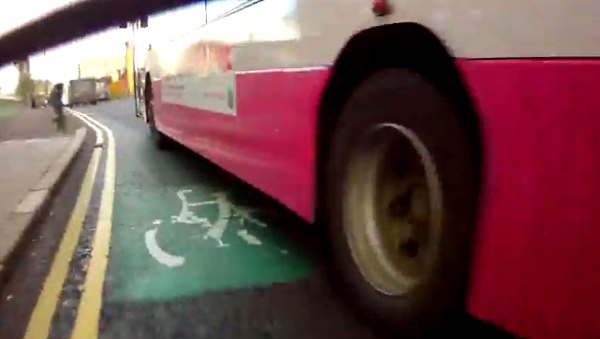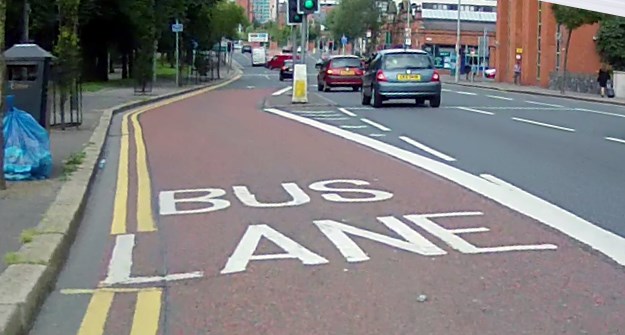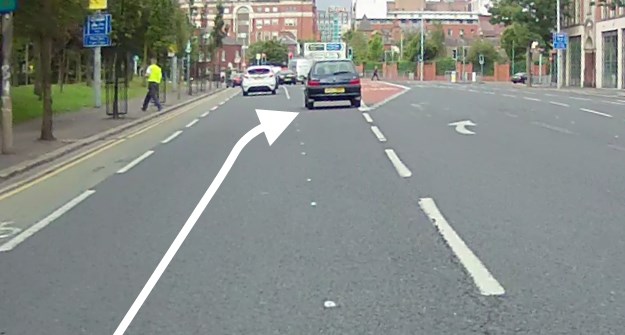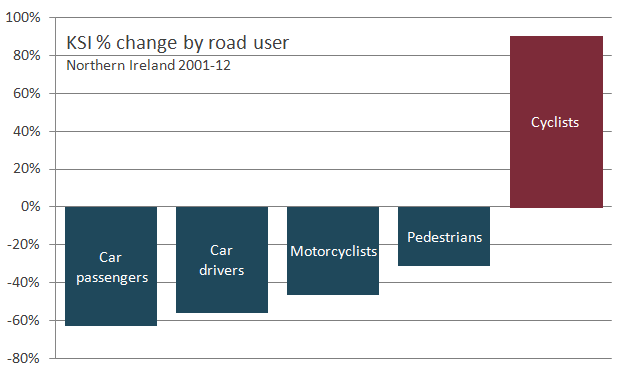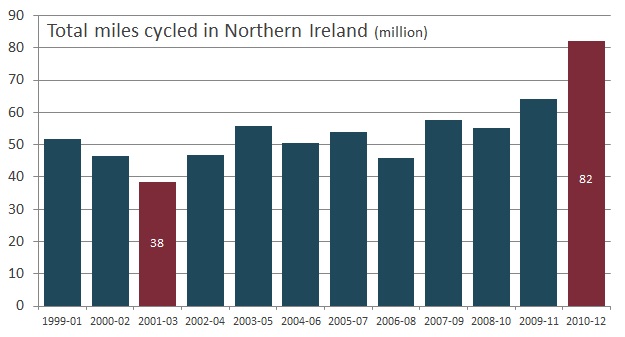Northern Ireland’s much heralded Cycling Revolution™ is going to need some great promotion to become a reality. Step forward our Department of the Environment (DOE), where local road safety promotion sits in isolation from the road builders (and revolutionary vanguard) over at the Department for Regional Development (DRD).
Recently DOE launched their first ever cycling safety video Respect everyone’s journey. It was a reasonable first effort, notwithstanding plenty of valid criticism. At least they wisely stayed away from the schlock-horror of their usual road safety adverts (see the international viral “hit” Shame on You).
A follow-up cycling video has been uploaded to YouTube, which shows how far DOE has slipped in just 3 months, and manages to perfectly capture how poor the cycling conditions and expectations are in Northern Ireland:
[youtube https://www.youtube.com/watch?v=sJ40bHE1OPA?rel=0&w=600&h=450]
.
Comments on YouTube are (wisely) switched off, but the video has already attracted scorn and ridicule on social media.
https://twitter.com/AngelaJWallace/status/490026202498072577
Here’s 10 of the top reasons why it’s so bad, in no particular order:
#1 That target audience?
It’s difficult to see who the video is trying to patronise reach. But on closer inspection..
“Cycling’s a great way to get around .. but that doesn’t mean you can forget about hazards, or who you share the space with .. we all have to respect everyone’s journey, whether you’re on the road, or in a cycle lane”
So it’s those death-wish cyclists with no regard for the rules of the road, who put themselves and others in danger, and generally don’t give a damn about respect – they’re the target audience. I reckon DOE’s instinct that a twee instructional video will make them think again is spot on.
#2 Image quality
As with DOE’s previous video, I’m already struggling to see cycling as normal because of the awful music. Simple Minds behind the scenes – indeed. And Chris and Erin seem dressed and ready to appear in a James Bond opening title sequence rather than going for a cycle, because NO-ONE DRESSES FOR CYCLING LIKE THAT. EVER.
Hiya DOE, here’s a modern image of cycling in Belfast, ironically taken the same day your video was published:

#3 Cycle tracks
Using the Stranmillis Embankment is an interesting choice. It’s by far and away the best on-road cycling space in Belfast, and was only just beaten into 2nd place by Derry’s Peace Bridge as NI’s best cycling infrastructure in the 2013 Fréd Awards.
It’s also wholly unrepresentative of the typical cycling experience here. In fact, there are just 3 separate cycle tracks in Belfast, totally just 2.5km in length. Making a video to explain how to use a cycle track (and generally how to interact with other humans) is overkill.
The Giro d’Italia passed along here in May 2014, but just weeks before the event, DRD’s Roads Service introduced another user to compete with cyclists – a variable message sign (and they got mildly arsey when people complained). Share the road indeed!
Roads Service. Pig-ignorant about cycling. Discuss. #cyclingrevolution pic.twitter.com/bVHO60Sbmo
— NI Greenways (@nigreenways) February 1, 2014
.
#4 “A good tip is to try and avoid the busiest times on your route; it’ll make your journey quicker, and smoother.”
According to DOE, cycling is not something you should be doing during rush hour; grow up and get a car for that, kids. It’s not like anyone would want to cycle to work, or to the shops in the morning, or hop on the bike for a 9am appointment etc.
@beta_dad @nigreenways "A wee tip, try to avoid the busiest times." Oh right, so no cycling to and from work then?
— Helen Flynn (@helstinki) July 18, 2014
If you’re daft enough to try it, expect a slow, rough journey. Hmm. Now you mention it, that’s a scarily accurate representation of cycling in Belfast’s rush hour. Finally some feckin’ honesty and insight – chapeau!
#5 Promoting shambolic infrastructure
At 3.42 and 4.35 I became convinced that the video was a scalpel-sharp piece of satire – you got me DOE! It’s one thing that the Ormeau Road Bus Shelter and University contra-flow lane were voted in the top 5 worst pieces of infrastructure in the 2013 Fréd Awards (beaten only by a dinosaur tail – true story), but quite another for the government to then think it appropriate to use them in a cycling promotion video.
Plonking a bus shelter in the middle of a shared use path is a nightmare for everyone using the space, more so for families with children or elderly people walking around the back. Don’t tell us how to navigate crap design, tell DRD how to redesign it!
https://twitter.com/ibikebelfast/status/490029456200040448
This is also NI’s first attempt on video to promote the contra-flow cycle lane concept, or at least DRD’s awfully executed attempt. If you need to use the phrases “But the danger is..” and “This is where you really need to be on high alert..” you’re admitting it’s dangerous crap, so just get rid of it!
https://twitter.com/AngelaJWallace/status/490024940624949248
.
#6 Those reflectors
While being thoroughly patronised by this video, I knew I’d have to admit that DOE had all their facts sewn up, that their advice was legally watertight and all information presented would be factually correct. Every scene shows someone cycling in daylight hours, not between sunset and sunrise. So it’s safe to assume when Erin says ‘by law, you must have a red rear reflector and amber pedal reflectors” that means not just when the sun’s gone down, right?
#7 “Bus lanes are there .. to make your journey smoother and faster, but because they’re shared with buses, permitted taxis and motorbikes, they can be extremely busy”
Damn right bus lanes are busy – by January 2015 DOE will create a single tier taxi system which will force the number of taxis in Belfast bus lanes up from 500 to around 4,000. Good idea to gloss over the destruction of cycling subjective safety at rush hour (hiya point #4).
Turns out (despite ridicule by DRD, MLAs, taxi lobby) this image & @LindaFStewart's taxi fleet story was near spot on pic.twitter.com/tFqi3PI30y
— NI Greenways (@nigreenways) July 16, 2014
.
#8 “Before you make any move .. always look around you, especially behind, and give a signal if necessary”
..says Erin at 4.20. Meanwhile, back in the mists of time at 4.10, the girl in the video makes a ridiculous move without signalling her intent to the Renault Clio. All happy smiles and waves in the video; try that in the real world, and there’s more chance she’d end up in A+E.
https://twitter.com/ellenfromnowon/status/490102359243378688
https://twitter.com/richardholywood/status/490042413487239168
.
#9 “By the way, footpaths (as the name suggests) are for feet”
Can you say ‘Equality Impact Assessment’? Wheelchair users and those on mobility scooters might have a few things to say about your interpretation here, DOE. While riding on many footways is illegal (footway or footpath – check those legals again) and generally frowned upon (never mind slower, bumpier and probably more dangerous) it’s a symptom of poor infrastructure – people are scared away from traffic, and want to cycle in what seems like a safer place. Build better routes and more protected cycling space, then people will simply choose the better alternative.
#10 “Respect other road users, because we all share the same space”
This is exactly the problem. The whole video is one long excuse for bad infrastructure, glossing over decades of under-investment in cycling. Countries with the highest cycling levels separate cycling as a transport mode distinct from motor vehicles and pedestrians, or unravels (high quality) cycling routes from the the busiest roads altogether.
DOE admits (whether knowingly or not) that trying to ride a bike around Belfast is made difficult and dangerous because cycling is not properly catered for, because we have to compete with cars, lorries, buses, taxis – and then offers up some random methods for coping, to varying degrees of usefulness.
* * * * *
Really, this only scratches the surface of the things which are obviously wrong with this video, and the swathes of underlying assumptions and daft language which other ‘road users’ are not subject to, like:
- more helmet nonsense, running counter to DOE’s more considered advice just 3 months ago
- cyclists have equal rights with dogs on shared paths – what progress..
- the need to be “courteous“, “show your appreciation“, “thank someone who lets you out“
- “cyclists must never jump red lights” klaxon
- the quite excellent “making sure .. you’re always visible” advice for all you see-through cyclists
@nigreenways my Highway Code must be fuzzy. I don’t recall the official hand signal for “thank someone who lets you out”.
— Stuart (mostly gone) (@stuartgibson) July 18, 2014
It’s a truly ill-advised piece of nonsense which does nothing to advance cycling promotion in Northern Ireland. Perhaps it’s time for DOE to fully hand over the reigns on this function to DRD’s Cycling Unit, who (from personal experience) actually know a thing or two about urban cycling.
@nigreenways Finally someone has EXPLAINED to me how to avoid mowing down children, dog walkers and pensioners.
Thanks DOE— Beta Papa (@beta_dad) July 18, 2014
https://www.facebook.com/BelfastBikefast/posts/317025061809199
https://twitter.com/vee_thirteen/status/490023337364443136
https://twitter.com/niroads/status/490233011670364160
@nigreenways bloody hell I managed 3mins of the patronising crap felt like I was being talked to like a kid. Since when was a bell a law??
— Stephen (@smadden85) July 18, 2014
https://twitter.com/BruteonaUte/status/490023126638817280


